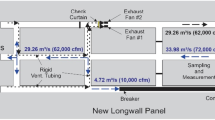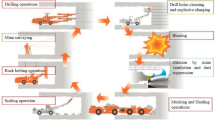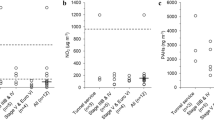Abstract
A study was conducted in an underground mine with the objective to identify, characterize, and source apportion airborne aerosols at the setup face and recovery room during longwall move operations. The focus was on contributions of diesel- and battery-powered heavy-duty vehicles used to transfer equipment between the depleted and new longwall panels and diesel-powered light-duty vehicles used to transport personnel and materials to various locations within the mine. Aerosols at the setup face were found to be distributed among diesel combustion-generated submicrometer and mechanically generated coarse aerosols. According to the data, the submicrometer aerosols downstream of the setup face were sourced to diesel exhaust emitted by vehicles operated inside and outside of the panel. Depending on the intensity of the activities on the panel, the outby sources contributed between 12.5 and 99.6% to the average elemental carbon mass flow at the setup face and recovery room. Extensively used light-duty vehicles contributed measurably to the elemental carbon concentrations at the setup face. The number concentrations of aerosols downstream of the setup face were associated with aerosols generated by combustion in diesel engines operated in the shield haulage loop and/or outside of the longwall panels. Entrainment of road dust by diesel or battery-powered load-haul-dump vehicles operated near the measurement site appears to be the primary source of mass concentrations of aerosols. The findings of this study should help the underground mining industry in its efforts to reduce exposures of miners to diesel and coarse aerosols.










Similar content being viewed by others
References
70 FR 24875 (2014) Mandatory health Standards - underground coal mines. Code of Federal Regulations Title 30, Part 70. Mine Safety and Health Administration, Department of Labor
66 FR 35518 (2001) Limit on exposure to diesel particulate matter. Code of Federal Regulations Title 30, Part 57.5060. Mine Safety and Health Administration, Department of Labor
Attfield MD, Morring K (1992) An investigation into the relationship between coal workers' pneumoconiosis and dust exposure in U.S. coal miners. Am Ind Hyg Assoc J 53(8):486–492. https://doi.org/10.1080/15298669291360012
Hnizdo E, Vallyathan V (2003) Chronic obstructive pulmonary disease due to occupational exposure to silica dust: a review of epidemiological and pathological evidence. Occup Environ Med 60:237–243. https://doi.org/10.1136/oem.60.4.237
Peters S, de Klerk N, Reid A, Fritischi L, Musk AW, Vermulen R (2017) Quantitative levels of diesel exhaust exposure and the health impact in the contemporary Australian mining industry. Occup Environ Med 74:282–289. https://doi.org/10.1136/oemed-2016-103808
Attfield MD, Schleiff PL, Lubin JH, Blair A, Stewart PA, Vermeulen R, Coble JB, Silverman DT (2012) The diesel exhaust in miners study: a cohort mortality study with emphasis on lung cancer. J Natl Cancer Inst 104:869–883. https://doi.org/10.1093/jnci/djs035
Silverman DT, Samanic CM, Lubin JH, Blair AE, Stewart PA, Vermeulen R, Coble JB, Rothman N, Schleiff PL, Travis WD, Ziegler RG, Wacholder S, Attfield MD (2012) The diesel exhaust in miners study: a nested case-control study of lung cancer and diesel exhaust. J Natl Cancer Inst 104:855–868. https://doi.org/10.1093/jnci/djs034
Power MC, Weiskopf MG, Alexeeff SE, Coull BA, Spiro A III, Schwartz J (2011) Traffic-related air pollution and cognitive functions in a cohort of older men. Environ. Health Perspect 119:682–687. https://doi.org/10.1289/ehp.1002767
Mills NL, Miller MR, Lucking AJ, Beveridge J, Flint L, Boere AJF, Fokkens PH, Boon NA, Sandstrom T, Blomberg A, Duffin R, Donaldson K, Hadoke PWF, Cassee FR, Newby DE (2011) Combustion-derived nanoparticulate induces the adverse vascular effects of diesel exhaust inhalation. Eur Heart J 32(21):2660–2671. https://doi.org/10.1093/eurheartj/ehr195
International Agency for Research on Cancer (2012) Diesel engine exhaust carcinogenic. IARC Press Release No. 213, June 12, World Health Organization. International Agency for Research on Cancer, Lyon, France
Cantrell BK, Volkwein JC (2001) Mine aerosol measurement. In: Baron PA, Willeke K (eds) Aerosol measurement. Principles, techniques, and applications, Second edn. John Willey & Sons, Inc, New York, pp 802–805
Rubow KL, Marple VA, Tao Y, Liu D (1990) Design and evaluation of a personal diesel aerosol sampler for underground coal mines. Soc Min Eng. AIME Preprint No. 90-132, pp. 5-9
Skubacz K, Wojtecki Ł, Urban P (2017) Aerosol concentration and particle size distributions in underground excavations of a hard coal mine. Int J Occup Safety Ergon 23(3):318–327. https://doi.org/10.1080/10803548.2016.1198553
Saarikoski S, Teinilä K, Timonen H, Aurela M, Laaksovirta T, Reyes F, Vásques Y, Oyola P, Artaxo P, Pennanen AS, Junttila S, Linnainmaa M, Salonen RO, Hillamo R (2018) Particulate matter characteristics, dynamics and sources in an underground mine. Aerosol Sci Technol 52(1):114–122. https://doi.org/10.1080/02786826.2017.1384788
McDonald JD, Zielinska B, Sagebiel JC, McDaniel MR, Mousset-Jones P (2003) Source apportionment of airborne fine particulate matter in an underground mine. J Air Waste Manag Assoc 53:386–395. https://doi.org/10.1080/10473289.2003.10466178
Heath Effects Institute (2002) Measuring diesel emissions exposure in underground mines: a feasibility study by Zielinska B, Sagebiel J, McDonald J, Rogers CF, Fujita E, Mousset-Jones P: Heath Effect Institute, Boston, MA pp 181–232
Bugarski AD, Schnakenberg GH Jr, Hummer JA, Cauda E, Janisko SJ, Patts LD (2009) Effects of diesel exhaust aftertreatment devices on concentrations and size distribution of aerosols in underground mine air. Environ Sci Technol 43:6737–6743. https://doi.org/10.1021/es9006355
Bugarski AD, Cauda E, Janisko SJ, Hummer JA, Patts LD (2010) Aerosols emitted in underground mine air by diesel engine fueled with biodiesel. J Air Waste Manag Assoc 60:237–244. https://doi.org/10.3155/1047-3289.60.2.237
Bugarski AD, Cauda EG, Janisko SJ, Patts LD, Hummer JA, Terrillion T, Keifer J (2012) Isolated zone evaluation of the Tier 4i engine equipped with SCR system. Proceeding of 14th United States/North American Mine Ventilation Symposium, Salt Lake City, UT, June 17-20, pp. 205-212
Mine Safety and Health Administration (2019) National coal diesel inventory. Available at https://www.msha.gov/support-resources/forms-online-filing/2018/05/23/manageupdate-diesel-inventory. Accessed July 23, 2019
The Raw Materials Group and Parker Bay Company (2012) Market analysis: underground mining mobile equipment. September. Stockholm, Sweden and Erie, Pennsylvania
66 FR 5704 (2001) Diesel particulate matter-underground areas of underground coal mines. Code of Federal Regulations Title 30 Part 72. Mine Safety and Health Administration, Department of Labor
69 FR 38957 (2004) Control of emissions of air pollution from nonroad diesel engines and fuel; final rule. Code of Federal Regulations Title 40, Parts 9, 69, 80, 86, 89, 94, 1039, 1048, 1051, 1065, and 1068. Environmental Protection Agency
Regulation (EU) 2016/1628 of the European Parliament and of the Council of 14 September 2016 on requirements relating to gaseous and particulate pollutant emission limits and type-approval for internal combustion engines for non-road mobile machinery, amending Regulations (EU) No 1024/2012 and (EU) No 167/2013, and amending and repealing Directive 97/68/EC. OJ L 252, 16.9.2016, p. 53–117
Bugarski AD, Janisko SJ, Cauda EG, Patts LD, Hummer JA, Westover C, Terrillion T (2014) Aerosols and criteria gases in an underground mine that uses FAME biodiesel blends. Ann Occup Hyg 58(8):971–982. https://doi.org/10.1093/annhyg/meu049
National Institute for Occupations Safety and Health: Effectiveness of selected diesel particulate matter control technologies for underground mining applications: isolated zone study, 2003 (2006). By Bugarski AD, Schnakenberg GH Jr., Noll JD, Mischler SE, Patts LD, Hummer JA, Vanderslice SE. (DHHS (NIOSH) Publication No. 2006–126, RI9667). Pittsburgh, PA: U.S. Department of Health and Human Services, Centers for Disease Control and Prevention
National Institute for Occupations Safety and Health: Effectiveness of selected diesel particulate matter control technologies for underground mining applications: isolated zone study, 2004 (2006). By Bugarski AD, Schnakenberg GH Jr., Mischler SE, Noll JD, Patts LD, Hummer JA (DHHS (NIOSH) Publication No. 2006–138, RI9668). Pittsburgh, PA: U.S. Department of Health and Human Services, Centers for Disease Control and Prevention
Ruehl C, Herner JD, Yoon S, Collins JF, Misra C, Na K, Robertson WH, Biswas S, Chang M-CO, Ayala A (2015) Similarities and differences between “traditional” and “clean” diesel PM. Emiss Control Sci Technol 1:17–23. https://doi.org/10.1007/s40825-014-0002-7
Khalek IA, Bougher TL, Merritt PM, Zielinska B (2011) Regulated and unregulated emissions from highway heavy-duty diesel engines complying with U.S. Environmental Protection Agency 2007 emissions standards. J Air Waste Manager. Assoc 61:427–442. https://doi.org/10.3155/1047-3289.61.4.427
Khalek IA, Blanks MG, Merritt PM, Zielinska B (2015) Regulated and unregulated emissions from modern 2010 emissions-compliant heavy-duty on highway diesel engines. J Air Waste Manager Assoc 65:987–1001. https://doi.org/10.1080/10962247.2015.1051606
Bugarski A, Barone T (2016) Controlling exposure of underground coal miners to diesel aerosols. Presentation at 22nd Annual MDEC Conference, Toronto, Ontario, Canada, October 4-6
Bugarski AD, Cauda EG, Barone TL, Vanderslice S (2017) Diesel particulate matter exposure and concentration monitoring in underground mines: Practices and challenges. Presentation at 23rd Annual MDEC Conference, Toronto, Ontario, Canada, October 3-5
Mine Safety and Health Administration (2019) The DPM personal sampling compliance data. Mine safety and health Administration. Available at https://arlweb.msha.gov/OpenGovernmentData/OGIMSHA.asp. Accessed July 23, 2019
61 FR 55518 (1996) Diesel power packages intended for use in areas of underground coal mines where permissible electric equipment is required. Code of Federal Regulations Title 30, Part 7. Subpart F. Mine Safety and Health Administration, Department of Labor
61 FR 55527 (1996) Nonpermissible diesel-powered equipment; categories. Code of Federal Regulations Title 30, Part 75.1908. Mine Safety and Health Administration, Department of Labor
Noll JD, Timko RJ, McWilliams LJ, Hall P, Haney R (2005) Sampling results of the improved SKC® diesel particulate matter cassette. J Occup Environ Hyg 2(1):29–37. https://doi.org/10.1080/15459620590900320
National Institute for Occupational Safety and Health (2016) Monitoring diesel exhaust in the workplace. In NIOSH Manual of Analytical Methods (NMAM), Birch EM,5th Edition, Chapter DL, Cincinnati, OH: U.S. Department of Health and Human Services, Centers for Disease Control and Prevention. Available from https://www.cdc.gov/niosh/nmam/pdfs/NMAM_5thEd_EBook.pdf. Accessed 26 Mar 2020
Ahlvik P, Ntziachristos L, Keskinen J, Virtanen A (1998) Real time measurement of diesel particle size distribution with an electric low pressure impactor. SAE Technical Paper 980410. https://doi.org/10.4271/980410
Keskinen J, Pietarinen K, Lehtimäki M (1992) Electrical low pressure impactor. J Aerosol Sci 23(4):353–360
National Institute for Occupational Safety and Health (2006) Laboratory and field performance of a continuously measuring personal respirable dust monitor. J.C. Volkwein, R.P. Vinson, S.J. Page, L.J. McWilliams, G.J. Joy, S.E. Mischler, and D.P. Tuchman. (DHHS (NIOSH) Publication No. 2006-145, RI 9669). U.S. Department of Health and Human Services, Centers for Disease Control and Prevention. Available at https://www.cdc.gov/niosh/mining/works/coversheet349.html. Accessed 26 Mar 2020
75 FR 17511 (2010). Coal Mine Dust Sampling Devices. Code of Federal Regulations Title 30, Part 74. Mine Safety and Health Administration, Department of Labor
Bugarski AD, Schnakenberg GH Jr, Hummer JA, Cauda E, Janisko SJ, Patts LD (2011) Evaluation of high-temperature disposable filter elements in an experimental underground mine. Society for Min. Metal Explor Trans 330:373–382
Bugarski AD, Hummer JA, Miller A, Patts LD, Cauda EG, Stachulak JS (2016) Emissions from a diesel engine using Fe-based fuel additives and sintered metal filtration system. Ann Occup Hyg 60(2):252–262. https://doi.org/10.1093/annhyg/mev071
Author information
Authors and Affiliations
Corresponding author
Ethics declarations
Conflict of Interest
All authors declare that they have no conflict of interest.
Disclaimer
The findings and conclusions in this manuscript are those of the authors and do not necessarily represent the views of the National Institute for Occupational Safety and Health (NIOSH) and the Center for Disease Control and Prevention (CDC). Mention of company names or products does not constitute endorsement by NIOSH or CDC.
Additional information
Publisher’s Note
Springer Nature remains neutral with regard to jurisdictional claims in published maps and institutional affiliations.
Rights and permissions
About this article
Cite this article
Bugarski, A.D., Hummer, J.A., Vanderslice, S. et al. Characterization of Aerosols in an Underground Mine during a Longwall Move. Mining, Metallurgy & Exploration 37, 1065–1078 (2020). https://doi.org/10.1007/s42461-020-00209-6
Received:
Accepted:
Published:
Issue Date:
DOI: https://doi.org/10.1007/s42461-020-00209-6




